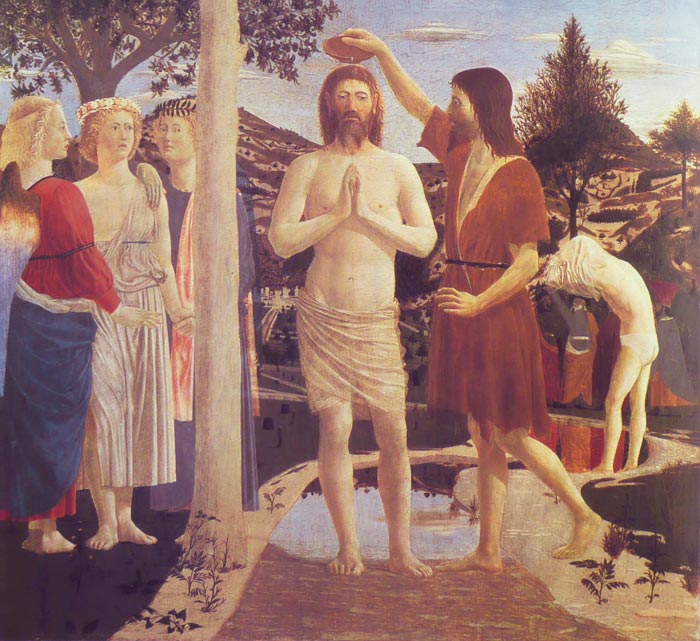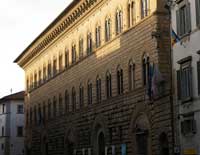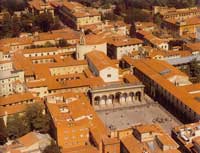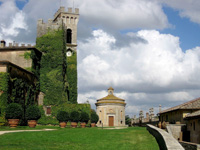| |
|
LIFE OF PIERO DELLA FRANCESCA [PIERO BORGHESE], PAINTER OF BORGO A SAN SEPOLCRO
|
|
Truly unhappy are those who, labouring at their studies in order to benefit others and to make their own name famous, are hindered by infirmity and sometimes by death from carrying to perfection the works that they have begun. And it happens very often that, leaving them all but finished or in a fair way to completion, they are falsely claimed by the presumption of those who seek to conceal their asses' skin under the honourable spoils of the lion. And although time, who is called the father of truth, sooner or later makes manifest the real state of things, it is none the less true that for a certain space of time the true craftsman is robbed of the honour that is due to his labours; as happened to Piero della Francesca of Borgo a San Sepolcro. He, having been held a rare master of the difficulties of drawing regular bodies, as well as of arithmetic and geometry, was yet not able—being overtaken in his old age by the infirmity of blindness, and finally by the close of his life—to bring to light his noble labours and the many books written by him, which are still preserved in the Borgo, his native place. The very man who should have striven with all his might to increase the glory and fame of Piero, from whom he had learnt all that he knew, was impious and malignant enough to seek to blot out the name of his teacher, and to usurp for himself the honour that was due to the other, publishing under his own name, Fra Luca dal Borgo, all the labours of that good old man, who, besides the sciences named above, was excellent in painting.
Piero was born in Borgo a San Sepolcro, which is now a city, although it was not one then; and he was called Della Francesca after the name[Pg 18] of his mother, because she had been left pregnant with him at the death of her husband, his father, and because it was she who had brought him up and assisted him to attain to the rank that his good-fortune held out to him. Piero applied himself in his youth to mathematics, and although it was settled when he was fifteen years of age that he was to be a painter, he never abandoned this study; nay, he made marvellous progress therein, as well as in painting. He was employed by Guidobaldo Feltro the elder, Duke of Urbino, for whom he made many very beautiful pictures with little figures, which have been for the most part ruined on the many occasions when that state has been harassed by wars. Nevertheless, there were preserved there some of his writings on geometry and perspective, in which sciences he was not inferior to any man of his own time, or perchance even to any man of any other time; as is demonstrated by all his works, which are full of perspectives, and particularly by a vase drawn in squares and sides, in such a manner that the base and the mouth can be seen from the front, from behind, and from the sides; which is certainly a marvellous thing, for he drew the smallest details therein with great subtlety, and foreshortened the curves of all the circles with much grace. Having thus acquired credit and fame at that Court, he resolved to make himself known in other places; wherefore he went to Pesaro and Ancona, whence, in the very thick of his work, he was summoned by Duke Borso to Ferrara, where he painted many apartments in his palace, which were afterwards destroyed by Duke Ercole the elder in the renovation of the palace, insomuch that there is nothing by the hand of Piero left in that city, save a chapel wrought in fresco in S. Agostino; and even that has been injured by damp. Afterwards, being summoned to Rome, he painted two scenes for Pope Nicholas V in the upper rooms of his palace, in competition with Bramante da Milano; but these also were thrown to the ground by Pope Julius II—to the end that Raffaello da Urbino might paint there the Imprisonment of S. Peter and the Miracle of the Corporale of Bolsena—together with certain others that had been painted by Bramantino, an excellent painter in his day.
|
 |
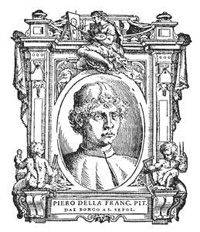 |
|
|
|
| |
|
|
|
|
Portraits of Federico da Montefeltro and His Wife Battista Sforza (1465-66)
|
|
Portraits of Federico da Montefeltro and His Wife Battista Sforza (1465-66), Panel, 47 x 33 cm (each), Galleria degli Uffizi, Firenze
|
|
Now, seeing that I cannot write the life of this man, nor particularize his works, because they have been ruined, I will not grudge the[Pg 19] labour of making some record of him, for it seems an apt occasion. In the said works that were thrown to the ground, so I have heard tell, he had made some heads from nature, so beautiful and so well executed that speech alone was wanting to give them life. Of these heads not a few have come to light, because Raffaello da Urbino had them copied in order that he might have the likenesses of the subjects, who were all people of importance; for among them were Niccolò Fortebraccio, Charles VII, King of France, Antonio Colonna, Prince of Salerno, Francesco Carmignuola, Giovanni Vitellesco, Cardinal Bessarione, Francesco Spinola, and Battista da Canneto. All these portraits were given to Giovio by Giulio Romano, disciple and heir of Raffaello da Urbino, and they were placed by Giovio in his museum at Como. Over the door of S. Sepolcro in Milan I have seen a Dead Christ wrought in foreshortening by the hand of the same man, in which, although the whole picture is not more than one braccio in height, there is an effect of infinite length, executed with facility and with judgment. By his hand, also, are some apartments and loggie in the house of the Marchesino Ostanesia in the same city, wherein there are many pictures wrought by him that show mastery and very great power in the foreshortening of the figures. And without the Porta Vercellina, near the Castle, in certain stables now ruined and destroyed, he painted some grooms currying horses, among which there was one so lifelike and so well wrought, that another horse, thinking it a real one, lashed out at it repeatedly with its hooves.
But to return to Piero della Francesca; his work in Rome finished, he returned to the Borgo, where his mother had just died; and on the inner side of the central door of the Pieve he painted two saints in fresco, which are held to be very beautiful. In the Convent of the Friars of S. Augustine he painted the panel of the high-altar, which was a thing much extolled; and he wrought in fresco a Madonna della Misericordia for a company, or rather, as they call it, a confraternity; with a Resurrection of Christ in the Palazzo de' Conservadori, which is held the best of all the works that are in the said city, and the best that he ever made. In company with Domenico da Vinezia, he painted the beginning of a work on the vaulting of the Sacristy of S. Maria at Loreto;[Pg 20] but they left it unfinished from fear of plague, and it was afterwards completed by Luca da Cortona,[3] a disciple of Piero, as will be told in the proper place.
Going from Loreto to Arezzo, Piero painted for Luigi Bacci, a citizen of Arezzo, the Chapel of the High-altar of S. Francesco, belonging to that family, the vaulting of which had been already begun by Lorenzo di Bicci. In this work there are Stories of the Cross, from that wherein the sons of Adam are burying him and placing under his tongue the seed of the tree from which there came the wood for the said Cross, down to the Exaltation of the Cross itself performed by the Emperor Heraclius, who, walking barefoot and carrying it on his shoulder, is entering with it into Jerusalem. Here there are many beautiful conceptions and attitudes worthy to be extolled; such as, for example, the garments of the women of the Queen of Sheba, executed in a sweet and novel manner; many most lifelike portraits from nature of ancient persons; a row of Corinthian columns, divinely well proportioned; and a peasant who, leaning with his hands on his spade, stands listening to the words of S. Helena—while the three Crosses are being disinterred—with so great attention, that it would not be possible to improve it. Very well wrought, also, is the dead body that is restored to life at the touch of the Cross, together with the joy of S. Helena and the marvelling of the bystanders, who are kneeling in adoration. But above every other consideration, whether of imagination or of art, is his painting of Night, with an angel in foreshortening who is flying with his head downwards, bringing the sign of victory to Constantine, who is sleeping in a pavilion, guarded by a chamberlain and some men-at-arms who are seen dimly through the darkness of the night; and with his own light the angel illuminates the pavilion, the men-at-arms, and all the surroundings. This is done with very great thought, for Piero gives us to know in this darkness how important it is to copy things as they are and to ever take them from the true model; which he did so well that he enabled the moderns to attain, by following him, to that supreme perfection wherein art is seen in our own time. In this same story he represented most success[Pg 21]fully in a battle fear, animosity, dexterity, vehemence, and all the other emotions that can be imagined in men who are fighting, and likewise all the incidents of battle, together with an almost incredible carnage, what with the wounded, the fallen, and the dead. In these Piero counterfeited in fresco the glittering of their arms, for which he deserves no less praise than he does for the flight and submersion of Maxentius painted on the other wall, wherein he made a group of horses in foreshortening, so marvellously executed that they can be truly called too beautiful and too excellent for those times. In the same story he made a man, half nude and half clothed in the dress of a Saracen, riding a lean horse, which reveals a very great mastery of anatomy, a science little known in his age. For this work, therefore, he well deserved to be richly rewarded by Luigi Bacci, whom he portrayed there in the scene of the beheading of a King, together with Carlo and others of his brothers and many Aretines who were then distinguished in letters; and to be loved and revered ever afterwards, as he was, in that city, which he had made so illustrious with his works.
|
Resurrection of Christ, Museo Civico, Sansepolcro
|
|
Piero della Francesca, The Resurrection, Museo Civico of Sansepolcro
|
In the Vescovado of the same city, also, he made a S. Mary Magdalene in fresco beside the door of the sacristy; and for the Company of the Nunziata he painted the banner that is carried in processions. At the head of a cloister at S. Maria delle Grazie, without that district, he painted S. Donatus in his robes, seated in a chair drawn in perspective, together with certain boys; and in a niche high up on a wall of S. Bernardo, for the Monks of Monte Oliveto, he made a S. Vincent, which is much esteemed by craftsmen. In a chapel at Sargiano, a seat of the Frati Zoccolanti di S. Francesco, without Arezzo, he painted a very beautiful Christ praying by night in the Garden.
In Perugia, also, he wrought many works that are still to be seen in that city; as, for example, a panel in distemper in the Church of the Nuns of S. Anthony of Padua, containing a Madonna with the Child in her lap, S. Francis, S. Elizabeth, S. John the Baptist, and S. Anthony of Padua. Above these is a most beautiful Annunciation, with an Angel that seems truly to have come out of Heaven; and, what is more, a row of columns diminishing in perspective, which is indeed beautiful. In the[Pg 22] predella there are scenes with little figures, representing S. Anthony restoring a boy to life; S. Elizabeth saving a child that has fallen into a well; and S. Francis receiving the Stigmata. In S. Ciriaco at Ancona, on the altar of S. Giuseppe, he painted a most beautiful scene of the Marriage of Our Lady.
Piero, as it has been said, was a very zealous student of art, and gave no little attention to perspective; and he had a very good knowledge of Euclid, insomuch that he understood all the best curves drawn in regular bodies better than any other geometrician, and the clearest elucidations of these matters that we have are from his hand. Now Maestro Luca dal Borgo, a friar of S. Francis, who wrote about the regular geometrical bodies, was his pupil; and when Piero, after having written many books, grew old and finally died, the said Maestro Luca, claiming the authorship of these books, had them printed as his own, for they had fallen into his hands after the death of Piero.
Piero was much given to making models in clay, on which he spread wet draperies with an infinity of folds, in order to make use of them for drawing.
A disciple of Piero was Lorentino d'Angelo of Arezzo, who made many pictures in Arezzo, imitating his manner, and completed those that Piero, overtaken by death, left unfinished. Near the S. Donatus that Piero wrought in the Madonna delle Grazie, Lorentino painted in fresco some stories of S. Donatus, with very many works in many other places both in that city and in the district, partly because he would never stay idle, and partly to assist his family, which was then very poor. In the said Church of the Grazie the same man painted a scene wherein Pope Sixtus IV, between the Cardinal of Mantua and Cardinal Piccolomini (who was afterwards Pope Pius III), is granting an indulgence to that place; in which scene Lorentino portrayed from the life, on their knees, Tommaso Marzi, Piero Traditi, Donato Rosselli, and Giuliano Nardi, all citizens of Arezzo and Wardens of Works for that building. In the hall of the Palazzo de' Priori, moreover, he portrayed from the life Cardinal Galeotto da Pietramala, Bishop Guglielmino degli Ubertini, and Messer Angelo Albergotti, Doctor of Laws; and he made many other works, which are scattered throughout that city. |
|
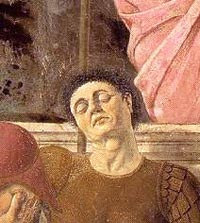
Piero della Francesca, The Resurrection
(self-portrait, detail of fresco), Museo Civico
of Sansepolcro
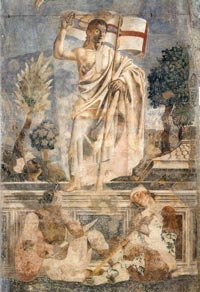 Andrea del Castagno, Resurrection, 1447, fresco, Sant'Apollonia, Florence Andrea del Castagno, Resurrection, 1447, fresco, Sant'Apollonia, Florence
|
Piero della Francesca | Baptism of Christ in Jordan (1460)
|
|
Piero della Francesca, The Baptism of Christ, detail (c. 1448-1450) - Tempera on panel, 168 x 116 cm, National Gallery, London
|
It is said that once, when the Carnival was close at hand, the children of Lorentino kept beseeching him to kill a pig, as it is the custom to do in that district; and that, since he had not the means to buy one, they would say, "What will you do about buying a pig, father, if you have no money?" To which Lorentino would answer, "Some Saint will help us." But when he had said this many times and the season was passing by without any pig appearing, they had lost hope, when at length there arrived a peasant from the Pieve a Quarto, who wished to have a S. Martin painted in fulfilment of a vow, but had no means of paying for the picture save a pig, which was worth five lire. This man, coming to Lorentino, told him that he wished to have the S. Martin painted, but that he had no means of payment save the pig. Whereupon they came to an agreement, and Lorentino painted him the Saint, while the peasant brought him the pig; and so the Saint provided the pig for the poor children of this painter.
Another disciple of Piero was Pietro da Castel della Pieve,[4] who painted an arch above S. Agostino, and a S. Urban for the Nuns of S. Caterina in Arezzo, which has been thrown to the ground in rebuilding the church. His pupil, likewise, was Luca Signorelli of Cortona, who did him more honour than all the others.
Piero Borghese, whose pictures date about the year 1458, became blind through an attack of catarrh at the age of sixty, and lived thus up to the eighty-sixth year of his life. He left very great possessions in the Borgo, with some houses that he had built himself, which were burnt and destroyed in the strife of factions in the year 1536. He was honourably buried by his fellow-citizens in the principal church, which formerly belonged to the Order of Camaldoli, and is now the Vescovado. Piero's books are for the most part in the library of Frederick II, Duke of Urbino, and they are such that they have deservedly acquired for him the name of the best geometrician of his time.
|
The Vision of Constantine
|
|
Piero della Francesca, Constantine's Dream, c. 1455, fresco, 329 x 190 cm, San Francesco, Arezzo
|
|
|
| |
|
 |
|
|
[1] Giorgio Vasari was an Italian painter, architect, and biographer, whose varied interests typify the intellectual artist/designer of the late Renaissance. He travelled extensively and contributed to the evolving character of court and church decoration in Florence and Rome. One of the earliest collectors of old master drawings, which he mounted in his Libro di Disegno, he was instrumental in the institution of the Florence Accademia del Disegno ( 1563 ). He is perhaps best known as the author of the Lives of the Most Excellent Painters, Sculptors, and Architects, in which he laid down the foundations of critical art historiography.
Vasari was born in Arezzo, into a family of artists and potters, and he claimed to have received his first drawing lessons from Luca Signorelli . He was taught painting in Arezzo by Guillaume de Marcillat, an artist familiar with the work of Michelangelo and Raphael in the Vatican, and in 1524 went with Cardinal Silvio Passerini to Florence, where he was taught with the young Medici, Alessandro and Ippolito. Here he acquired a knowledge of Latin and classical themes, as well as training with the artists Andrea del Sarto and Bandinelli and briefly meeting Michelangelo. When the Medici were expelled from Florence in 1527 he returned to Arezzo, and met Rosso Fiorentino , but in 1529 was again in Florence apprenticed as a goldsmith. In 1532 he studied art and architecture in Rome with Salviati.
From this point he worked successfully as a painter mainly in Florence and Rome, securing commissions from the Medici, for example the posthumous portrait of Lorenzo il Magnifico ( 1534 ; Florence, Uffizi), and for large-scale court and civic projects like the decorations for the entry of Charles V into Florence in 1536 .
Vasari's principal paintings are fresco cycles, evidence of his talent as a decorator and organizer of large workshops, but he executed some significant altarpieces. The Immaculate Conception for SS Apostoli, Florence, which derives from a composition by Rosso, is elegant and fluid in style and influenced the interpretation of the subject. His major fresco schemes, while stylistically eclectic, are notable for their learned and mythological references. The ‘100 Days Fresco’ (Rome, Cancelleria) depicts deeds of Pope Paul III within a grandiose setting of fictive architecture, and the lavish decoration of his own house in Florence includes illustrations of Pliny's anecdotes of the artists of Antiquity. From 1554 Vasari was responsible for the architectural remodelling and decoration of the Palazzo Vecchio, Florence, as a ducal residence for Cosimo de'Medici. With the help of numerous assistants he produced a historical and allegorical programme which focuses on the contribution of Medici patrons to the rebirth of the arts, and which culminates in the apotheosis of Cosimo I, the personification of Florentine history. Of Vasari's architectural works, the Uffizi illustrates well his design skills. It housed the various administrative offices of Florence in its two wings, thereby representing civic centralization. However, the arrangement of the offices is clearly indicated on the façades by a series of entrances marked by Doric columns and piers.
The Lives, first published in 1550 , was dedicated to Cosimo de'Medici, and includes an introduction to the three arts and three sections of biographies, the only living artist included being Michelangelo. Vasari believed that art is primarily the imitation of nature, progress in art consisting of the perfecting of the means of representation. His view was that this perfection had been achieved by the artists of classical Antiquity, and, after a period of decline during the Middle Ages, was gradually restored by the artists of Tuscany. He divided the process of revival into three epochs, a concept familiar in Antique literature and one he also applied in his classification of Antique art. These began with the primi lumini Cimabue and Giotto , whose imitation of nature was improved by the augmenti of the 15th century and culminated in the perfezione of Michelangelo and his contemporaries. This chronological perception of stylistic development, based on truth to nature, and the linking of classical with 16th-century art became the basis of subsequent art historical method.
In addition Vasari built on earlier theorists like Alberti in formulating a method of stylistic analysis, in which he emphasized the fundamental role of disegno, for all three arts, and established aesthetic criteria by which art could be judged. Each biography presents the individual artist's character and contribution against this broader background of artistic development and evaluation.
The enlarged edition of the Lives ( 1568 ) expands on the histories of artistic techniques, describes individual genres, and introduces the classification of artists by region as well as by techniques. There are more biographies, many of them now of living artists, and various private collections are mentioned. A broad picture is thus presented, of the history of taste as well as of style and method. Although Vasari's biographical and anecdotal accuracy can sometimes be questioned, the Lives is one of the most valuable sources for the period covered and for the outlook on art which it embodies.
[Giorgio Vasari Biography - ( 1511 - 74 ), Lives of the Most
Excellent Painters, Sculptors, and Architects]
Bibliography
Rubin, P. L. , Giorgio Vasari: Art and History (1995).
Satkowski, L. , Giorgio Vasari, Architect and Courtier (1993).
Le vite de'più eccellenti pittori, scuttori e architetti. Florence: Lorenzo Torrentino, 1550. Enlarged ed., Florence: T. Giunti, 1568.
Lives of the Most Eminent Painters, Sculptures and Architects. Translated by Gaston du C. de Vere. 10 vols. London: Macmillan and the Medici Society, 1912-15; Ragionamenti del Sig. cavaliere Giorgio Vasari, pittore et architetto aretino, sopra le inuentioni da lui dipinte in Firenze nel palazzo di Loro Altezze Serenissime. Florence: F. Giunti, 1588.
|
|

Cover of "Le Vite" |
|
|
|
|
|
Palazzo Medici Riccardi, Florence |
|
Piazza della Santissima Annunziata
in Florence |
|
Florence, Duomo |
Giorgio Vasari Biography - ( 1511 - 74 ), Lives of the Most
Excellent Painters, Sculptors, and Architects

|
|
|
Giorgio Vasari | Lives of the Most Eminent Painters Sculptors and Architects
Art in Tuscany | Art in Tuscany | Giorgio Vasari | Lives of the Most Excellent Painters, Sculptors, and Architects
Volume I | Cimabue to Agnolo Gaddi
Volume II | Berna to Michelozzo Michelozzi
Volume III | Filarete And Simone To Mantegna
Volume IV | Filippino Lippi To Domenico Puligo
Volume V | Andrea Da Fiesole to Lorenzo Lotto
Volume VI | Fra Giocondo To Niccolò Soggi
Volume VII | Tribolo to Il Sodoma
Volume VIII | Bastiano to Taddeo Zucchero
Volume IX | Michelagnolo To The Flemings
Lives of the Most Eminent Painters Sculptors and Architects, Giorgio Vasari | download pdf
|
|
|
|
Wikimedia Commons has media related to Le Vite.
|

Holiday accomodation in Tuscany | Podere Santa Pia | Artist and writer's residency
|
| |
|
|
|
|

. |
|
|
Podere Santa Pia |
|
Podere Santa Pia, garden view, April |
|
View from Podere Santa Pia
on the coast and Corsica |
| |
|
|
|
|
|
|
|
|
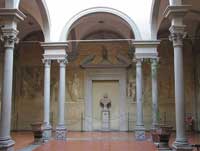
|
Villa Celsa near Florence |
|
Piazza della Santissima Annunziata
in Florence |
|
Choistro dello Scalzo, Florence |
| |
|
|
|
|
| |
|
|
|
|
| |
|
|
![]()

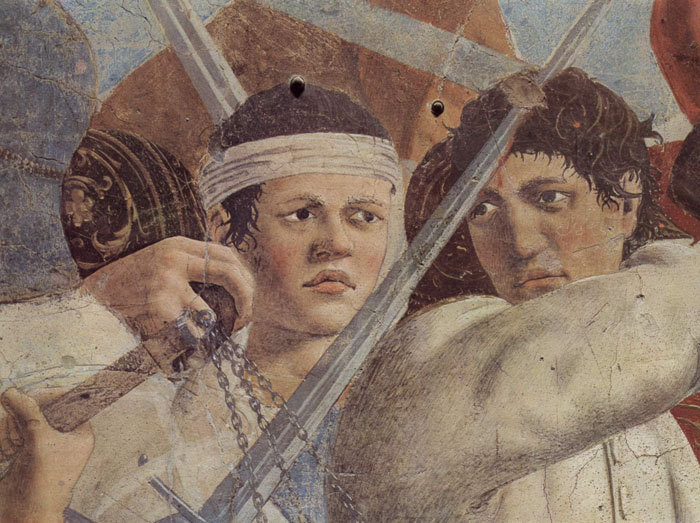

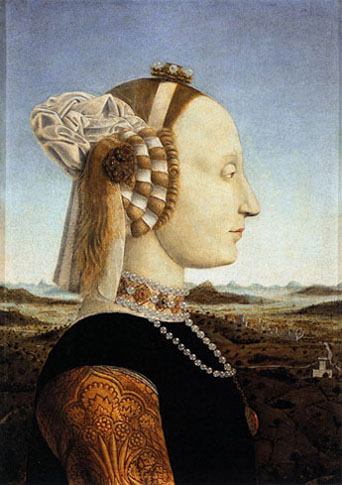
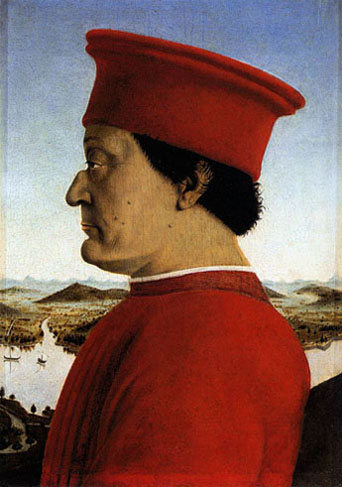
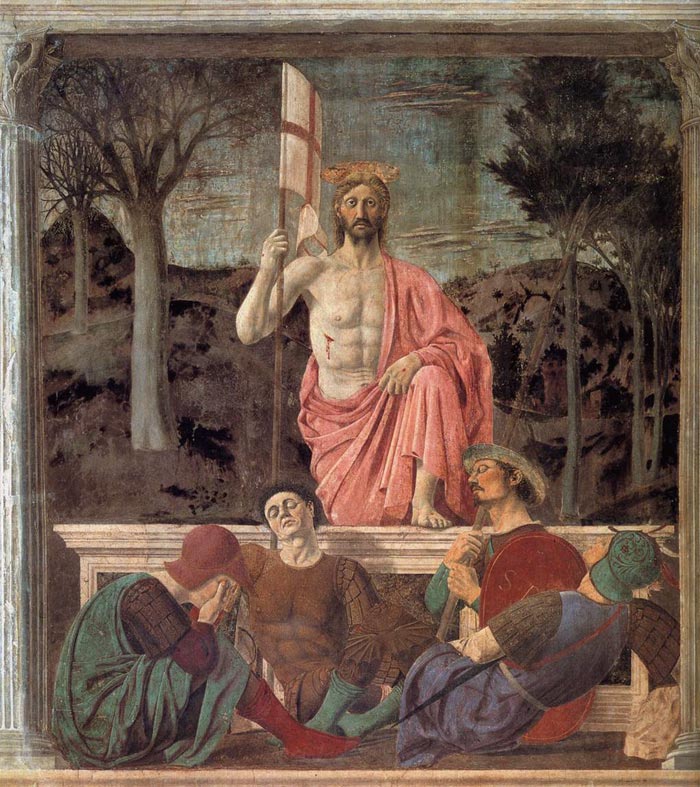

 Andrea del Castagno, Resurrection, 1447, fresco, Sant'Apollonia, Florence
Andrea del Castagno, Resurrection, 1447, fresco, Sant'Apollonia, Florence 